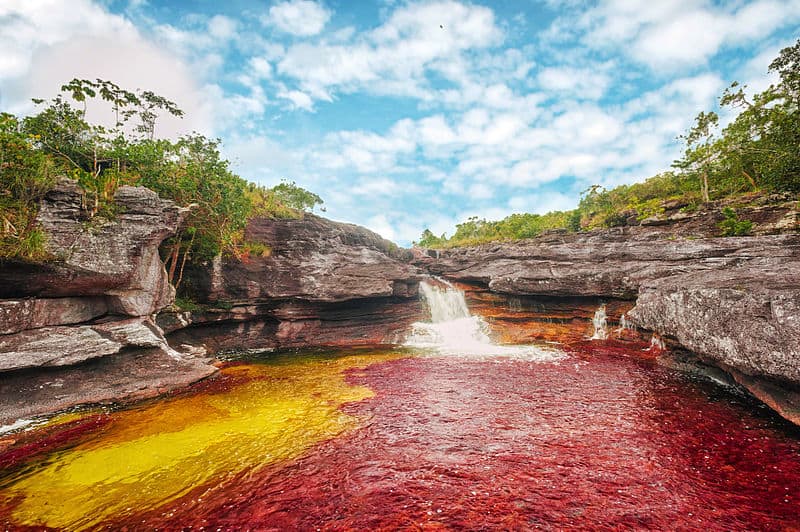
Cano Cristales Facts
- This astounding marvel of Nature forms a watery kaleidoscope bearing the name of Cano Cristales, Crystal Channel in English. Its mesmerizing beauty, quite understandably, entrances all those fortunate enough to encounter it in person.
- This wonder of natural forces also goes by several other names, especially among local residents. These alternate names include such terms as the Liquid Rainbow and the River of Five Colors, just to list a few of the many descriptive titles used.
- This astonishing semblance further occurs due to a very unique and breathtaking combination of geological and botanical factors. As a result of its appearance, many individuals consider Cano Cristales to be the most beautiful river on earth.
- This opinion originates, quite understandably, as a result of the fact that the river presents five separate colors. For about half of the year, however, only four of the gorgeous colors appear visible. That alone, though, makes it highly remarkable.
- During the other half of the year, nonetheless, the fifth color quickly appears as well, dazzling the viewer. This, therefore, completes the dazzling transformation of the river. The colors presented include those of green, yellow, blue, black, and red.
Related Articles
Onyx River Verdon Gorge Coyote Gulch
Cano Cristales Physical Description
Leading off the wonders of the gorgeous site, much of the riverbed of Cano Cristales formed covered with rocks composed of quartzite. These rocks, understandably, for those with a knowledge of geology, form the source of the four colors present in the river year round.
The stones of this incredible site further originated with the Serraina de la Macarenia tableland. This formation, itself quite impressive, also measures at around 1.2 billion years old. Because of this age, these comprise some of the oldest exposed rocks known to man.
The marvel of Cano Cristales also represents an extremely fast flowing river. Due to this, the body of water, not surprisingly, possesses numerous waterfalls and powerful rapids. Nature also carved many deep cavities in the geology of the river bed over time.
Cano Cristales Location, Flora, and Fauna
Perhaps most notably, the truly extraordinary river named Cano Cristales formed in a comparatively remote region of the globe. That area consists of what now forms the country of Colombia, in South America. This unique river further lies within in the province of Meta.
This magnificent site also boasts yet another outstanding feature to set it apart. It actually has a border composed of three quite large and distinct ecosystems. In point of fact, these consist of the Eastern Llanos, the Andes, and also the amazing Amazon rainforest.
Each of these equally remarkable and beautiful ecosystems also contributes its own great diversity of flora and fauna to the river. This fact only serves to enhance the already extensive charms of the body of water. The river therefore owes its nature to many factors.
One of these many factors also serves as the source of the seasonally occurring fifth color in the river. This appears due to the presence of the aquatic plant Macarenia clavigera. It blooms in vast quantities on the rocks on the riverbed and grows bright red in color.
Finally, within the many types of environments it touches on, the predominant biome of Cano Cristales equals a hydrophytic rainforest. The surrounding region serves as home to 420 known species of birds, 43 species of reptiles, 8 primates, and 420 avian species.
Features Sharing Its Region
Enchanted Well Gocta Cataracts Salar de Uyuni
Check out our other articles on 5 Spellbinding Scorpions, Linville Falls, Longfin Batfish, Tiger Flower, Gharial, Cape Honey Bee, Northern Bald Ibis, Limnonectes larvaepartus

